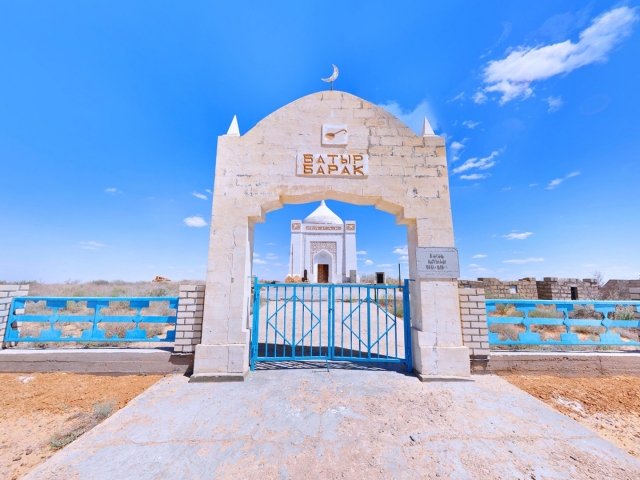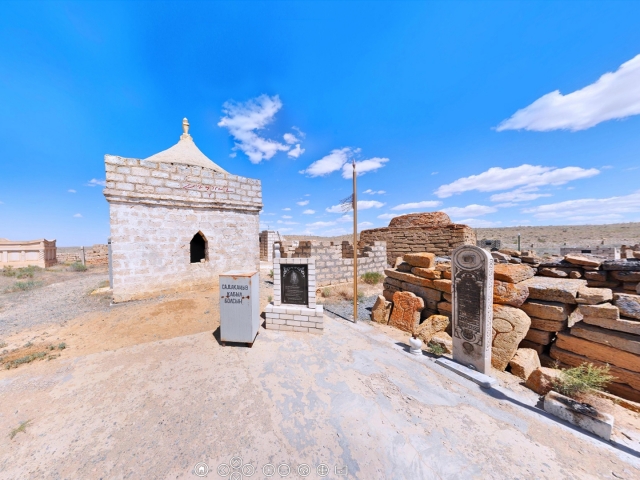Places
List of objects included in the map
Barak Satybaldyuly Mausoleum
Location: located in Beineu district of Mangistau region, 13 km to the south from Turysh village.
Coordinates: N 45°23' 19.45", E 56°15' 10.75"
Description of the Monument: The necropolis was first taken under state account 1993 as a monument of local value. There is tomb of Barak-batyr the necropolis, a native of Tabyn tribe of junior zhuz. The domed mausoleum at the place of burial was erected in 1993. The mausoleum has rectangular shape and three tiers according to local architectural tradition. The inner and outer walls are faced with limestone. On the main facade there is an inscription 'Barak-Batyr'. On this wall there is an arch and an entrance opening; on the outside of the arch there are botanical patterns. The ornaments have a 'U' shaped setting. The remaining 3 walls around the 'U' shaped setting are decorated with geometric patterns. In the upper part there are three-quarter corner columns. On the front of the two columns there are engraved images of batyr's weapons (axe, sword, helmet). Chief master: architect M. S. Nurabayev.
Historical Data, Legends and Stories: Barak Satybaldyuly (1743-1840) is the batyr who headed the national liberation movement of the Kazakhs of the junior zhuz. He was born in Ustyurt in the area of the Sam sands. At the age of 18 he won a fight with Torgaut batyr Alakobik. In the 70-ies of the 18th century Barak-batyr the leader of Shomishty-Tabyn tribes participated in battles with the Kalmucks on the banks of Yedil and Zhaiyk rivers. In 1785-1792 he became one of the leaders of Syrym Datov's movement.
In the 70-ies of the 18th century Barak-batyr the leader of Shomishty-Tabyn tribes participated in battles with the Kalmucks on the banks of Yedil and Zhaiyk rivers. Baron O. Ighelstrom wrote about Barak's insistence in a letter to the Empress Catherine II. His military actions against the violence from the Russian side allowed to keep the Kazakh land on the right coast of Zhaiyk river. He denied the influence of Russia on the west of Kazakhstan, did not allow construction of military fortresses. Barak-batyr is buried in the current Beineu district of Mangystau region.
In 1993 a modern mausoleum is built to the batyr's memory by architect M. Nurkabayev. Chief master – architect M. S. Nurkabayev.
Public activist H. Dosmukhambetov described the uprising of Issatai-Makhambet and disobedience of the junior zhuz and noted: 'The goal of the tsar's government was to fully capture the Kazakh people, as Kazakhstan was a direct route to Asia. The only solution was to get rid of the government. Russian officials remained a desire to possess the junior zhuz via trading.'
Barak's son Assau Satybaldyuly and grandson Dauit were also famous warriors.
Many legends and stories were told about Barak-batyr. When Barak-batyr went to liberate Aishuak-khan, he left his 13-year-old son Assau alone at home. But the old men of the tribe were all over the boy, assuring that he needs to help his father. In order that the father does not recognize him Assau put on his hat and went to the battle. The old men told him not to take off his hat even his head would be sweating. Not a single arrow could get him. Becket-Ata and Barak-Ata were contemporaries, good friends, respected each other. In the legend 'Becket-Ata and Barak-batyr' there is a story of seven swans. Barak-batyr said to Becket: 'When you rode your horse seven swans flew in front of you. Seven generations will know of your greatness.' Becket replied: 'Three swans flew in front of you. You will have only three descendants.' In fact Barak had only one son Assau and grandson Dauit. Among the Kazakhs there were a few warriors named Barak. And they all remained in people's memory as liberators and enemy defeaters.
Sources:
- Documents of the Reserve;
- Encyclopedia 'Mangistau'.
- 'Reference of Arabic Graph Texts on the Historical
and Cultural Sites in Aral-Caspian Interfluve', volume 1, N.A. Kulbayev,
Almaty-2015
Views: 3283
Video
3D Модель
Маршрут
Hazret Yerzhan Burial
Shopan Ata Necropolis and Underground Mosque
Shakpak Ata Necropolis and Underground Mosque (14th–19th centuries)
Khatam-Ishan Mausoleum
The earliest structures here date back to the second half of the 17th c. The necropolis was developed in time and space in a circle, i.e. the most ancient constructions remained in the center. Out of the two extant domed mausoleums, the structure in the southern part of the necropolis is of particular interest. ...















